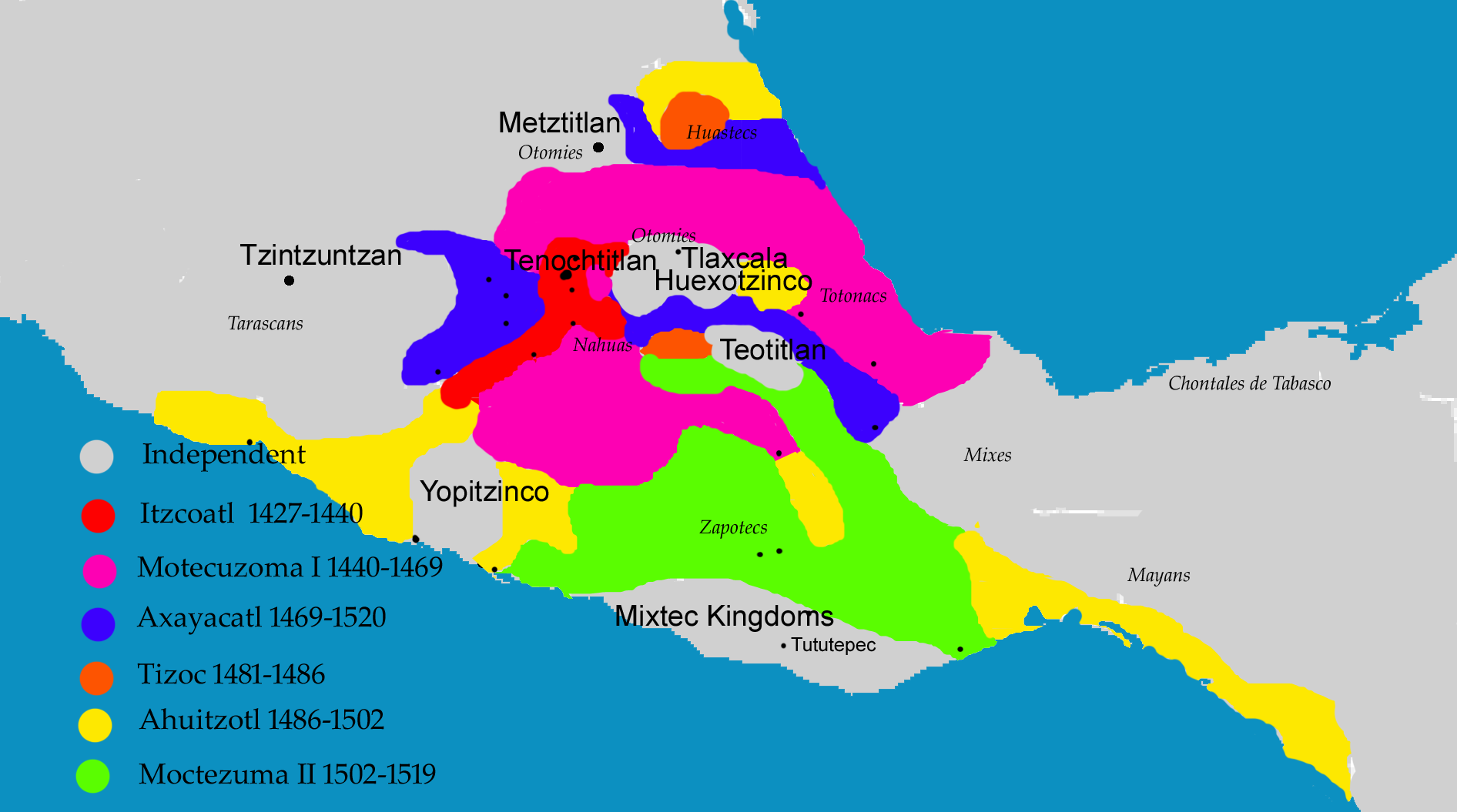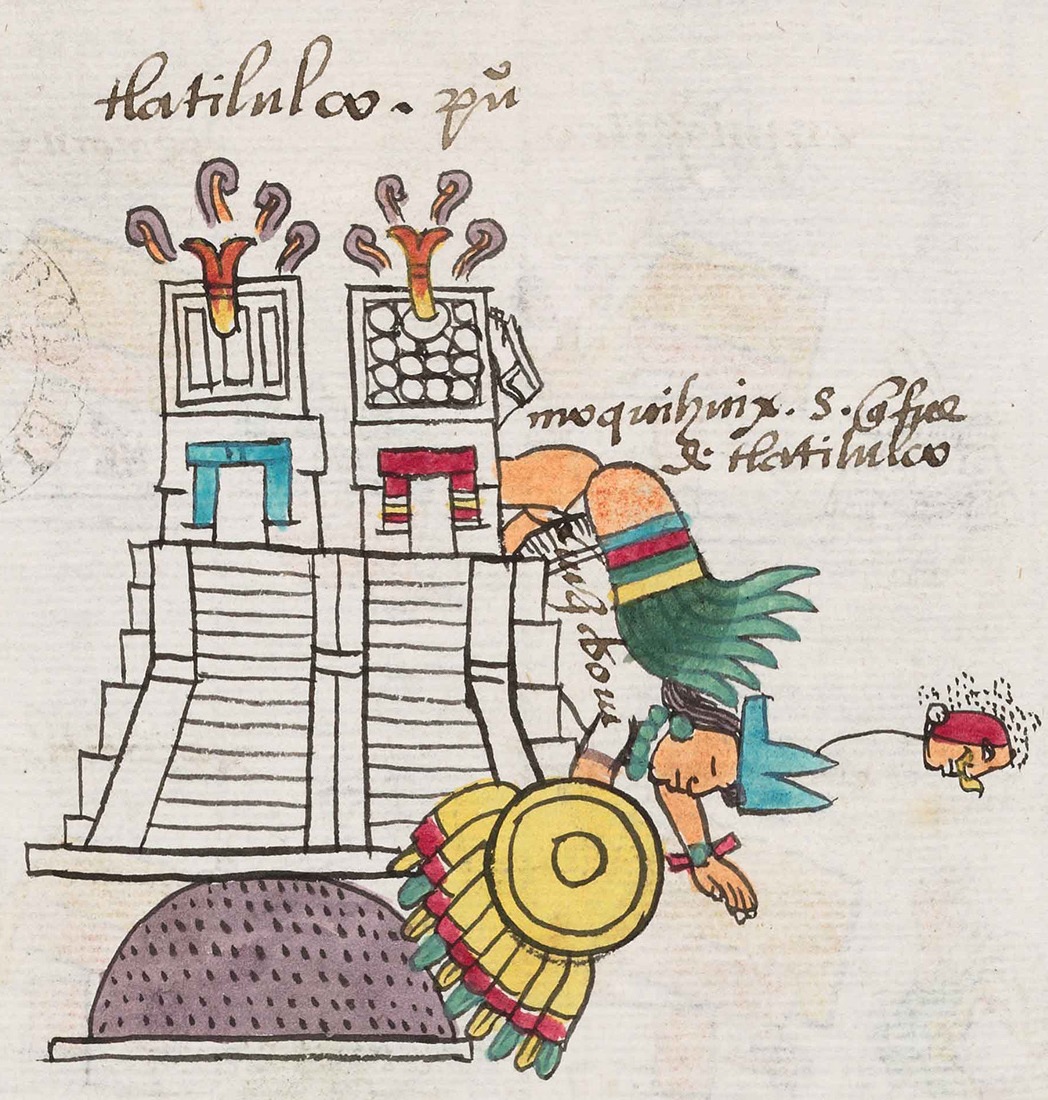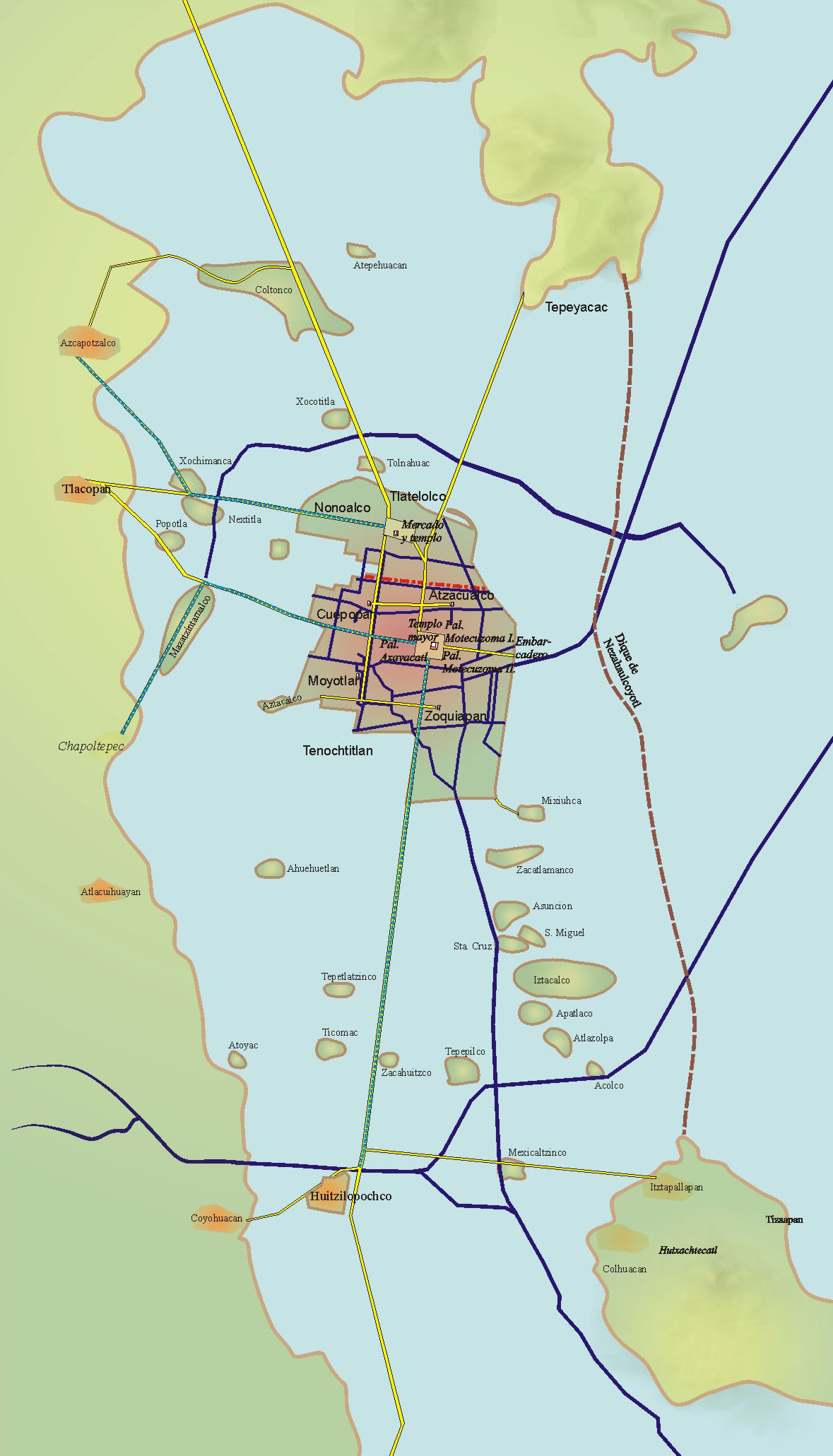|
Chichimecacihuatzin II
Chichimecacihuatzin II ('Little/Revered Chichimec Woman', ) was an Aztec princess of Tenochtitlan in Mexico. Etymology The Nahuatl name ''Chīchīmēcah'' (plural, pronounced ; singular ''Chīchīmēcatl'') means "inhabitants of Chichiman"; the placename Chichiman itself means "Area of Milk". The word could either have a negative "barbarous" sense, or a positive "noble savage" sense. Biography Chichimecacihuatzin was a daughter of Emperor Moctezuma I and his cousin-wife, Queen Chichimecacihuatzin I, after whom she was named.Family of Chichimecacihuatzin is mentioned by Chimalpahin. She was a granddaughter of the king Cuauhtototzin and emperor Huitzilihuitl. Her sister was Atotoztli II and her nephews were kings Axayacatl, Tizoc and Ahuitzotl. They all ruled over Tenochtitlan as great emperors. Her husband was Huehue Huanitzin, a "great leader" of Itztapalapan and her son was Chimalpilli I (died in 1465). He was the first king of Ecatepec Ecatepec (), officially Ecatepec ... [...More Info...] [...Related Items...] OR: [Wikipedia] [Google] [Baidu] |
Princess
Princess is a title used by a female member of a regnant monarch's family or by a female ruler of a principality. The male equivalent is a prince (from Latin '' princeps'', meaning principal citizen). Most often, the term has been used for the consort of a prince, or for the daughter of a monarch. A crown princess can be the heir apparent to the throne or the spouse of the heir apparent. Princess as a substantive title Some princesses are reigning monarchs of principalities. There have been fewer instances of reigning princesses than reigning princes, as most principalities excluded women from inheriting the throne. An example of a princess regnant is Constance of Antioch, princess regnant of Antioch in the 12th century. Since the president of France, an office for which women are eligible, is ''ex-officio'' a co-prince of Andorra, then Andorra could theoretically be jointly ruled by a princess. Princess as a courtesy title Descendants of monarchs For many centurie ... [...More Info...] [...Related Items...] OR: [Wikipedia] [Google] [Baidu] |
Huitzilihuitl
Huitzilihuitl () or Huitzilihuitzin (Nahuatl language; English: ''Hummingbird Feather'') (1370s – ''ca.'' 1417) was the second ''Tlatoani'' or king of Tenochtitlan. According to the Codex Chimalpahin, he reigned from 1390 to 1415, according to the Codex Aubin, he reigned from 1396 to 1417 and according to the Codex Chimalpopoca, he reigned from 1403 to 1417. Biography Family and childhood HuitzilĂhuitl was born in Tenochtitlan, and was the son of Acamapichtli, first ''tlatoani'' of the Mexica, and Queen Tezcatlan Miyahuatzin, and had a half-brother Itzcoatl. His maternal grandfather was Acacitli. Only 16 years old when his father died, Huitzilihuitl was elected by the principal chiefs, warriors and priests of the city to replace him. At that time, the Mexica were tributaries of the Tepanec city-state of Azcapotzalco. Reign HuitzilĂhuitl, a good politician, continued the policies of his father, seeking alliances with his neighbors. He founded the Royal Council or ''T ... [...More Info...] [...Related Items...] OR: [Wikipedia] [Google] [Baidu] |
Pagans
Pagans may refer to: * Paganism, a group of pre-Christian religions practiced in the Roman Empire * Modern Paganism, a group of contemporary religious practices * Pagan's Motorcycle Club, a motorcycle club * The Pagans The Pagans were an American punk rock band from Cleveland, Ohio, United States, that was originally active from 1977 to 1979. They reformed several times, from 1982 to 1983, from 1986 to 1989 and again from 2014 to 2017. Along with fellow Clev ..., a 1970s American punk band * ''The Pagans'' (film), a 1953 Italian film See also * Pagan (other) {{disambig ... [...More Info...] [...Related Items...] OR: [Wikipedia] [Google] [Baidu] |
Princesses
Princess is a title used by a female member of a regnant monarch's family or by a female ruler of a principality. The male equivalent is a prince (from Latin '' princeps'', meaning principal citizen). Most often, the term has been used for the consort of a prince, or for the daughter of a monarch. A crown princess can be the heir apparent to the throne or the spouse of the heir apparent. Princess as a substantive title Some princesses are reigning monarchs of principalities. There have been fewer instances of reigning princesses than reigning princes, as most principalities excluded women from inheriting the throne. An example of a princess regnant is Constance of Antioch, princess regnant of Antioch in the 12th century. Since the president of France, an office for which women are eligible, is ''ex-officio'' a co-prince of Andorra, then Andorra could theoretically be jointly ruled by a princess. Princess as a courtesy title Descendants of monarchs For many centurie ... [...More Info...] [...Related Items...] OR: [Wikipedia] [Google] [Baidu] |
Ecatepec
Ecatepec (), officially Ecatepec de Morelos, is a municipality in the State of Mexico situated in the north of the Greater Mexico City urban area. The municipal seat is San CristĂłbal Ecatepec. The city of Ecatepec is co-extensive with the municipality, comprising 99% of the total population of 1,645,352. It is Mexico's third most-populous municipality after Tijuana and the 16 boroughs of Mexico City. It is also the most-populous suburb of Greater Mexico City. The name "Ecatepec" is derived from Nahuatl and means "windy hill" or "hill devoted to Ehecatl" (the wind god). It was also an alternative name for or invocation of the god Quetzalcoatl. "Morelos" refers to JosĂ© MarĂa Morelos, a hero of the Mexican War of Independence. Saint Christopher is the city's patron saint, celebrated on July 25. Ecatepec is served by the Mexico City metro, by the State of Mexico's MexibĂşs bus rapid transit lines, and by Mexicable aerial cable car lines. Points of interest include the C ... [...More Info...] [...Related Items...] OR: [Wikipedia] [Google] [Baidu] |
Ahuitzotl
Ahuitzotl (, ) was the eighth Aztec ruler, the '' Huey Tlatoani'' of the city of Tenochtitlan, son of princess Atotoztli II. His name literally means "Water Thorny" and was also applied to the otter. It is also theorized that more likely, the animal called ahuitzotl is actually the water opossum, the hand symbolizing its prehensile tail, which otters notably lack. Either Ahuitzotl or his predecessor Tizoc was the first ''tlatoani'' of Tenochtitlan to assume the title ''Huey Tlatoani'' ("supreme ''tlatoani''") to make their superiority over the other cities in the Triple Alliance (Aztec Empire) clear. Ahuitzotl was responsible for much of the expansion of the Mexica domain, and consolidated the empire's power after emulating his predecessor. He took power as Emperor in the year 7 Rabbit (1486), after the death of his predecessor and brother, Tizoc. He had two sons, the kings Chimalpilli II and Cuauhtémoc, and one daughter. Biography Perhaps the greatest known military lead ... [...More Info...] [...Related Items...] OR: [Wikipedia] [Google] [Baidu] |
Tizoc
Tizocic (), or Tizocicatzin (), usually known in English as Tizoc, was the seventh tlatoani of Tenochtitlan, ''tlatoani'' of Tenochtitlan. His name means, "He who makes sacrifices" or "He who does penance." Either Tizoc or his successor Ahuitzotl was the first ''tlatoani'' of Tenochtitlan to assume the title ''Huey Tlatoani'' ("supreme ''tlatoani''") to make their superiority over the other cities in the Triple Alliance (Aztec Empire) clear. Biography Family Tizoc was a son of the princess Atotoztli II and her cousin, prince Tezozomoc (son of Itzcoatl), Tezozomoc. He was a grandson of Emperors Moctezuma I and Itzcoatl. He was a descendant of the King Cuauhtototzin. He was successor of his brother Axayacatl and was succeeded by his other brother, Ahuitzotl; his sister was the Queen Chalchiuhnenetzin, married to Moquihuix, tlatoani of Tlatelolco (altepetl), Tlatelōlco. He was an uncle of Emperors Cuauhtémoc, Moctezuma II and Cuitláhuac and grandfather of Diego de San Francis ... [...More Info...] [...Related Items...] OR: [Wikipedia] [Google] [Baidu] |
Axayacatl
Axayacatl (; ; ; meaning "face of water"; –1481) was the sixth of the of Tenochtitlan and Emperor of the Aztec Triple Alliance. Biography Early life and background Axayacatl was a son of the princess Atotoztli II and her cousin, prince Tezozomoc (son of Itzcoatl), Tezozomoc. He was a grandson of the Emperors Moctezuma I and Itzcoatl. He was a descendant of the king Cuauhtototzin. He was a successor of Moctezuma and his brothers were Emperors Tizoc and Ahuitzotl and his sister was the Queen Chalchiuhnenetzin. He was an uncle of the Emperor Cuauhtémoc and father of Emperors Moctezuma II and Cuitláhuac. Rise to power During his youth, his military prowess gained him the favor influential figures such as Nezahualcoyotl (tlatoani), Nezahualcoyotl and Tlacaelel I, and thus, upon the death of Moctezuma I in 1469, he was chosen to ascend to the throne, much to the displeasure of his two older brothers, Tizoc and Ahuitzotl. It is also important that the Aztec calendar stone, ... [...More Info...] [...Related Items...] OR: [Wikipedia] [Google] [Baidu] |
Atotoztli II
Atotoztli ( ) or Huitzilxochtzin ( ) was an Aztec princess and possible regent. She was a daughter of the Aztec emperor Moctezuma I and Chichimecacihuatzin I, the daughter of Cuauhtototzin, the ruler of Cuauhnahuac. Life She married Tezozomoc, son of the previous emperor Itzcoatl, and gave birth to three sons who would later become emperors themselves: Axayacatl, Tizoc, and Ahuitzotl. Some sources indicate she served as ''tlatoani'' herself. The ''Anales de Tula'' and ''RelaciĂłn de la GenealogĂa'' state she ruled the Triple Alliance herself, possibly for as long as 30 years. If true, the records of the Mexica may have omitted her from the records because she was a woman. On the other hand, the documents supporting these claims were not contemporary, and made on request of Juan Cano de Saavedra to support the claims of his wife Isabel Moctezuma as heiress to Tenochtitlan. She may have acted as regent for her son Ahuitzotl, who may have been too young to act as a ruler ... [...More Info...] [...Related Items...] OR: [Wikipedia] [Google] [Baidu] |
Cuauhtototzin
Cuauhtototzin () was a king of Cuauhnahuac. Family Cuauhtototzin was a son and successor of King Tezcacohuatzin. His sister was Empress Miahuaxihuitl. He was a father of Empress Chichimecacihuatzin I and uncle of her husband Moctezuma I. Cuauhtototzin was a grandfather of Princess Atotoztli II, who was a mother of kings Axayacatl, Tizoc and Ahuitzotl Ahuitzotl (, ) was the eighth Aztec ruler, the '' Huey Tlatoani'' of the city of Tenochtitlan, son of princess Atotoztli II. His name literally means "Water Thorny" and was also applied to the otter. It is also theorized that more likely, the .... Family tree See also * List of people from Morelos References {{Reflist SourcesTlahuica Peoples of Morelos*Visions of Paradise: Primordial Titles and Mesoamerican History in Cuernavaca by Robert Haskett Tlatoque ... [...More Info...] [...Related Items...] OR: [Wikipedia] [Google] [Baidu] |
Tenochtitlan
, also known as Mexico-Tenochtitlan, was a large Mexican in what is now the historic center of Mexico City. The exact date of the founding of the city is unclear, but the date 13 March 1325 was chosen in 1925 to celebrate the 600th anniversary of the city. The city was built on an island in what was then Lake Texcoco in the Valley of Mexico. The city was the capital of the expanding Aztec Empire in the 15th century until it was Fall of Tenochtitlan, captured by the Tlaxcaltec and the Spanish in 1521. At its peak, it was the largest city-state, city in the pre-Columbian Americas. It subsequently became a ''Municipalities of Mexico, cabecera'' of the Viceroyalty of New Spain. Today, the ruins of are in the historic center of the Mexican capital. The World Heritage Site of contains what remains of the geography (water, boats, Chinampa, floating gardens) of the Mexica capital. was one of two Mexica (city-states or Polity, polities) on the island, the other being . Etymol ... [...More Info...] [...Related Items...] OR: [Wikipedia] [Google] [Baidu] |



